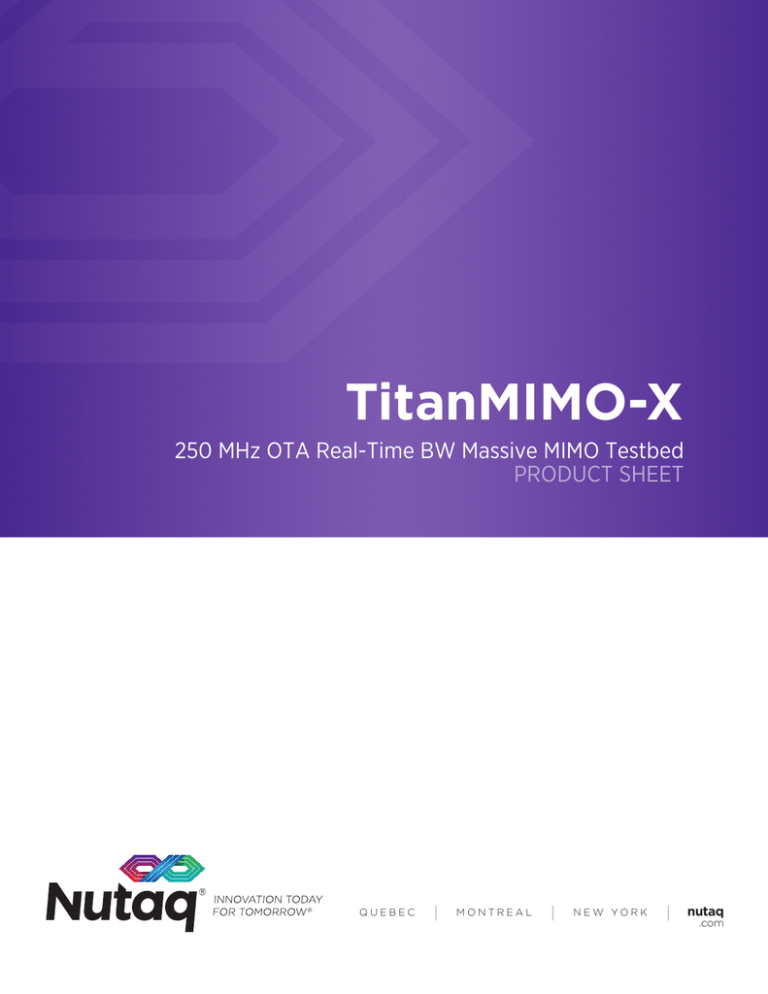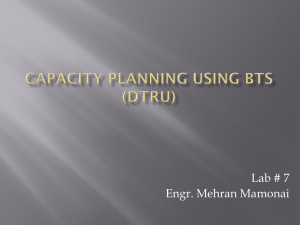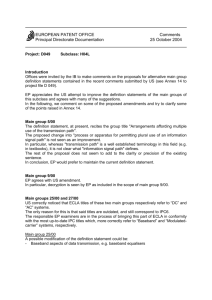
TitanMIMO-X
250 MHz OTA Real-Time BW Massive MIMO Testbed
PRODUCT SHEET
QUEBEC
I
MONTREAL
I
N E W YO R K
I
nutaq
.com
TitanMIMO-X
5G, Millimeter Wave and Massive MIMO research without the shortage in real-time computing
•
•
•
•
Complete baseband processing including ADC and DAC converters
Up to 250 MHz OTA baseband bandwidth real-time processing
Up to 800 IQ samplers
(or 400 antenna elements)
Truly scalable & upgradable
100% Data Throughput
Unrestricted data throughput channel
aggregation, required for Massive
MIMO baseband processing. Avoid
standard backplane bandwidth
restriction and undeterministic
communication protocol.
Single FPGA
•
•
•
Friendly interface for user supplied external RF (millimeter wave as example)
Includes phased aligned sampling clock synchroniser system
Truly scalable & upgradable
Distributed FPGA
Clusters
Scalable baseband processing through
modular approach and user-defined
mesh topology. Benefits from the most
advanced industry telecom standards
(MTCA + ATCA + FMC).
Modular RF-BW Growth
Through the use of standard FMC
modules, the Testbed is fully
upgradable to next generations
including higher bandwidth through
different sampling rates support. IQ
sampler modules (ADCs/DACs) can
be replaced with currently available
complete RF interface modules (radio
head) for sub-6GHz applications (see
TitanMIMO-6 Series).
TitanMIMO-X Solution
TitanMIMO X series Massive MIMO testbeds are scalable
solutions that can meet any processing and channel count
for real-time and very large antenna arrays research.
Why Testbed Implementation and Validation:
• Validate various waveform propagation
schemes
• Optimize network deployment by balancing cost versus performance
• Validate interoperability scenarios
• Validate, optimize & develop analytic channel models
• Optimize TDD and RF calibration techniques
Testbed Main Components:
RRH-4TRX (Radio Remote Head):
4 TRX capable, 250 MHz OTA BW
RRH includes Nutaq’s multichannel high speed conversion
FMC module (MO1000-8 and MI250).
The MI250 module provides 8x 250 MSPS, 14-bit ADCs while
the MO1000-8 provides 8x 250 MSPS DACs, 16-bit with
embedded NCO and interpolators for up to 1 GHz update
rate.
Each module supports onboard and external clocking
modes, allowing a common phased-aligned clock source
provided to each RRHs to perfectly match and align the
sample clocks.
Additionally, the RRHs are based on a dual FMC HPC carrier
(Nutaq’s Perseus 611X) to support both the MI250 and
MO1000-8 modules while providing a large FPGA for pre/
post-processing and 7x user-defined 20 Gbps P2P cable
interfaces for channel aggregation or mesh-processing
between multiple RRH or to Nutaq’s octal Virtex-6 baseband
core module (Kermode XV6).
This powerful baseband processor unit offers tremendous
FPGA processing capabilities (8x Virtex-6) and up to 32x
user-defined 20 Gbps P2P cable interfaces for channel
aggregation and mesh processing by stacking cards
together to scale the processing or channel count to very
large numbers.
Finally, user defined digital control lines are also available
to facilitate user-provided RF front-end interface that may
be coupled to the available baseband samplers (8x ADCs,
8x DACs). Considering baseband IQ complex components
topology would be used, a maximum of 4x RF transceivers
may be used per RRH for a 250 MHz BW (I:250MSPS +
Q:250MSPS = 500 MSPS effective real component sample
rate).
RRH-8TRX (Radio Remote Head):
8 TRX capable, 125 MHz OTA BW
RRH includes Nutaq’s multichannel high speed conversion
FMC module (MO1000-16 and MI125-16).
The MI125-16 module provides 16x 125 MSPS, 14-bit ADCs
while the MO1000-16 provides 16x 250 MSPS DACs, 16bit with embedded NCO and interpolators for up to 1 GHz
update rate.
Each module supports onboard and external clocking mode,
allowing a common phased-aligned clock source provided
to each RRHs to perfectly match and align the sample
clocks.
Additionally, the RRHs are based on a dual FMC HPC carrier
(Nutaq’s Perseus 611X) to support both the MI125-16 and
MO1000-16 modules while providing a large FPGA for pre/
post-processing and 7x user-defined 20 Gbps P2P cable
interfaces for channel aggregation or mesh-processing
between multiple RRH or to Nutaq’s octal Virtex-6 baseband
core module (Kermode XV6).
This powerful baseband processor unit offers tremendous
FPGA processing capabilities (8x Virtex-6) and up to 32x
user-defined 20 Gbps P2P cable interfaces for channel
aggregation and mesh processing by stacking cards
together to scale processing or channel count to very large
numbers.
Finally, user defined digital control lines are also available
to facilitate user-provided RF front-end interface that may
be coupled to the available baseband samplers (16x ADCs,
16x DACs). Considering baseband IQ complex components
topology would be used, a maximum of 8x RF transceivers
may be used per RRH for a 125 MHz BW (I:125MSPS +
Q:125MSPS = 250 MSPS effective real component sample
rate).
Octal V6 Baseband Core Module
This baseband processing module (Nutaq’s Kermode XV6)
provides tremendous processing capabilities through its
on-board 8x Virtex-6 large FPGAs (SX475T).
The aggregation of all channels to a common central
processing unit without real-time restriction or bandwidth
compromise is just one of the features this module
provides. Additionally, each FPGA interfaces with two DDR3 SDRAM SODIMM modules, capable of supporting up to 4
GBytes, for an aggregate memory capacity of 64 GBytes.
The Kermode-XV6 supports various user-defined
interconnection modes with the RRH or between multiple
baseband processor through its RTM interface (Rear
Transition Module).
16x 20 Gbps full-duplex P2P cable connection on the Front
Panel (typically interfacing RRH)
16x 20 Gbps full-duplex P2P cable connection on the RTM
side (typically for interconnection between multiple Octal
V6 Baseband Core Modules)
System Synchronization
Radio Remote Heads (RRH)
A common time base
Each Nutaq RRH includes a multichannel (8 or 16x) ADC
module and a multichannel (8 or 16x) DAC module,
considering an IQ topology for the user-defined RF, giving a
total of four (250 MHz BW), or eight (125 MHz BW) TRX per
RRH. Each ADC/DAC module has an onboad CLK but can
also accept an external CLK input.
On top of synchronising the sample CLKs for beamforming
applications, the uSync CLK module allows CLK disciplining
to an external reference or embedded GPS.
In order to synchronise all converters, Nutaq provides uSync
CLKs 19’’ rackmount modules to accomplish these tasks
(LOs module may also be available for user supplied RF).
The uSync systems are specifically designed to ensure phase
coherency between all CLKs and are even stackable to scale
for clocking very large systems.
The user selected reference can then be distributed
on all RRH and octal V6 baseband processor cores to
ensure precise time-based communication between all
FPGAs within the system, through the use of VITA49
communication protocols.
Through the uTCA/ATCA backplane, the PPS and 10 MHz
time signals are distributed to ensure a deterministic
communication system.
User-defined cabled link topologies
Nutaq RRHs and Octal V6 Baseband Core modules are
interconnected using cabled link technology that supports
multiple communication topologies and which are userdefined, adaptable and scalable to multiple baseband
processing schemes. This provides the TitanMIMO testbed
with almost infinite flexibility and reduces risks associated
with fixed solutions that can’t be adapted and can’t scale
(see next section model examples).
These 20 Gbps full-duplex links per cable are offered
over Mini-SAS physical interfaces (Nutaq selected these
interfaces due to their small form factor, available high
speed rate and low cost compared to existing SFP-type
interfaces). Each of the Mini-SAS connection are directly
interfaced to 4x Virtex-6 FPGA’s full-duplex high speed MGT
(Multi-Gigabit Transceiver) interface.
These physical interfaces can support multiple protocol
layers. Provided with TitanMIMO development software are
high-speed and low-latency Aurora-4x protocol (20 Gbps)
full duplex interface supported per cable link. Customers
may use these physical interface to support other telecom
standard such as CPRI protocol for validating scenarios that
are much closer to final deployment scenarios. These MiniSAS cable links can be offered in either copper or optical
versions, allowing the RRHs to be located far from the
baseband processing.
To better understand the throughput capacity of the
TitanMIMO X series, for each RRH (4-TRX 250 MHz or
8-TRX 125 MHz versions), two 20 Gbps links are required to
support the full data rate of the all transceivers in sustain
real-time operation (No decimation/upconvertion within
Virtex-6 RRH’s FPGA : Bypass-mode), thus freeing the
remaining links (5x) for other interconnection purpose as
described in the configuration examples of the next section.
Configuration Examples
TitanMIMO-XS 125MHz OTA 32 TRX (64 ADCs / 64 DACs)
TitanMIMO-XS 250MHz OTA 16 TRX (32 ADCs / 32 DACs)
Note: A low cost 32 transceiver (125MHz OTA BW) or 16 transceiver (250MHz OTA BW) testbed built combining 4x RRH and aggregating all channels to a
master RRH for baseband processing.
TitanMIMO-XD 125MHz OTA 64 TRX (128 ADCs / 128 DACs)
TitanMIMO-XD 250MHz OTA 32 TRX (64 ADCs / 64 DACs)
Note: A 64 transceiver (125MHz OTA BW) or 32 transceiver (250MHz OTA BW) testbed built combining 8x RRH and aggregating all channels to a master
octal V6 baseband processing core.
TitanMIMO-XD 125MHz OTA 128 TRX (256 ADCs / 256 DACs)
TitanMIMO-XD 250MHz OTA 64 TRX (128 ADCs / 128 DACs)
Note: A 128 transceiver (125MHz OTA BW) or 64 transceiver (250MHz OTA BW) testbed built combining 16x RRH and aggregating all channels to 2x octal
V6 baseband processing core where a master core does the final aggregation.
Model Comparison Chart
Model
RF Tuning
Range
OTA Real- # TRX
Time BW Channels
TitanMIMO-XS-125 32TRX
TitanMIMO-XD-125 64TRX
125 MHz
TitanMIMO-XD-125 128TRX
TitanMIMO-XS-125 NTRX
TitanMIMO-XS-250 16TRX
User
Provided
FE
dependent
TitanMIMO-XD-250 32TRX
TitanMIMO-XD-250 64TRX
TitanMIMO-XS-250 NTRX
250 MHz
# ADCs /
# DACs
# RRH Nodes
(Perseus 611x)
# Octal V6 Baseband # Virtex-6
Processor Cores
FPGAs
(Kermode XV6)
32
64/64
4
0 (baseband
processing
implemented on
master RRH)
64
128/128
8
1
16
128
256/256
16
2
32
Userdefined. Up
to 400 TRX
channels
possible
Userdefined.
Up to 800
ADCs/DACs
possible
4
User-defined
16
32/32
4
0 (baseband
processing
implemented on
master RRH)
32
64/64
8
1
16
64
128/128
16
2
32
Userdefined. Up
to 200 TRX
channels
possible
Userdefined.
Up to 400
ADCs/DACs
possible
User-defined
4
Massive MIMO Reference Design
As part of the TitanMIMO-X system, a reference design is
provided which enables developers to rapidly implement
Massive MIMO applications without dealing with baseband
sampling phase synchronisation, data communications
issues, data synchronization, using the right set of APIs etc.
The reference design supports the data transfer,
aggregation, and control of all samplers through the central
baseband processing engine, and back to the radio nodes.
HetNet, MU-MIMO and CRAN Testbed Ready
Nutaq’s Digitizer systems (PicoDigitizer) can be combined
with the TitanMIMO system to build up complete HetNet,
MU-MIMO or CRAN testbed solutions envolving both BTS
and UE, enabling the evaluation of interoperability behavior
for various deployment scenarios.
Massive MIMO HetNet Testbed
CRAN Optional Testbed Scheme
Record & Playback
Each RRH (8 TRXs) is equipped with a 4 GB SDRAM FPGA
memory, which allows for recording of the full signal
bandwidth, as shown in the example below:
• Eight RF channels sampled at 245.76 MSPS.
• Each sample has 2 Bytes.
• Therefore 3932.16 MBps throughput are needed to record
all 8 TRX at full speed to the SDRAM
(8 x 245.76 MSPS x 2 Byte/Sample = 3932.16 MBps).
• Maximum SDRAM throughput: 5700 MBps.
Thus, the record/playback FPGA module provided within
each RRH enables record or playback for all channels of the
entire Massive Mimo testbed. A maximum of 250 MegaSamples per channel can be recorded to the SDRAM (4 GB
divided by 8 channels divided by 2 Bytes per channel). This
translates to a total recording of 1 second (or a continuous
playback) for all channels of the testbed at full rate (245.76
MSPS). Additionally, synchronous record (or playback) of all
channels can be performed though the time based control
of each RRH (see synchronization section above).
Record & Playback Operating Modes
Single Shot
Normal
Continuous
Record: Fill up memory from RF,
stop, then download data to PC.
ecord: Fill up memory, stop, download data to
R
PC, then re-arm trigger.
Playback: Upload file, playback
from memory to RF.
layback: Upload file, playback from memory to
P
RF
layback: Upload file, playback memory in a
P
continuous loop.
Record & Playback Trigger Modes
External
FPGA based
Time-based software
An external trigger for each 4x4
MIMO subsystem is available
The trigger signal can be defined by user logic
within the FPGA of each 4x4 MIMO subsystem
The trigger signal can be sent from the central
processor unit using time based events
High Speed Real-Time Data Exchange (RTDEx) with embedded CPU (4C i7)
Nutaq RTDEx IP core provides an extensive framework to
exchange data with the embedded host device for transport
layer implementation through the PCIe or GigE links with
the highest bandwidth and lowest latency possible. On
both interfaces (FPGA & CPU), DMA engines initiates
data transfer at very high speed through simple API calls,
enabling the channel aggregates processed in the last
FPGA in the baseband processing chain to send/receive the
demodulated data to the embedded CPU at up to 10 Gbps.
HOST - FPGA Streaming
GigE
PCIe 4x (Gen 1)
Data Throughput
1 Gbps
10 Gbps
True Data Throughput (no overhead)
~ 900 Mbps
~ 6.4 Gbps
Roundtrip Latency (4KB, send&receive)
~ 1 msec
~ 200 - 300 µsec
TitanMIMO-X Specifications
General System Specifications
TitanMIMO-XS
Maximum user-supplied TRX supported
Up to 32 TRX
Maximum RRH supported
Up to 4 RRH
TitanMIMO-XD
Scalable up to 400 TRX*
(64 TRX per Octal V6 BB Core)
Up to 48 RRH* (8x per Octal V6 BB Core)
RF Specification
User Provided FE dependent
Real-Time OTA RF BW
Up to 250 MHz
System Throughput at Central Baseband Processing
140 Gbps (Master RRH)
Up to 2 Tbps
(320 Gbps per Octal V6 BB Core)
Sustained System Throughput at Central Baseband
Processing (w/o overhead)
112 Gbps (Master RRH)
Up to 1.5 Tbps
(256 Gbps per Octal V6 BB Core)
Central Baseband Processor Technology
Up to 4x Xilinx Virtex-6 FPGAs
Up to 96x Xilinx Virtex-6 FPGAs (16x per
Octal V6 BB Core)*
CPU Master Controller
Intel 4C i7
2x GigE
Network Remote Interface
Form Factor
MTCA.4
MTCA.4 + ATCA
System Size
12U Rackmount**
26U Rackmount**
Power, Cooling & Shelf Management
Yes
Sampler Control Interface
PCIe 4x
ADC/DAC-to-Baseband Reference Design
Yes
Record/Playback Tools
Yes
ADC/DAC Phase Synchronization Mode
Phase Coherent Sampling
*More TRX, RRH and FPGA resources available by combining large baseband processor cards (Kermode XV6)
**Dimensions may differ depending on MTCA/ATCA chassis provided
RRH (Perseus 611x + MI125/MI250 + MO1000) Specifications
TitanMIMO-XS
FPGA
64 bit DDR3 SDRAM SODIMM Memory
RTM (Rear Transition Module)
CTRL Interfaces
Form Factor
TitanMIMO-XD
1x Virtex-6 LX550T/SX475T
4 GB
28 GTX (7x Aurora-4x / Mini-SAS)
PCIe-4x or GigE
AMC Full-Size (MTCA.4)
16 ADCs, 16 DACs (125 MHz OTA BW)
# ADCs/DACs per RRH
Or
8 ADCs, 8 DACs (250 MHz OTA BW)
ADCs bit width
14
DACs bit width
16
# FMC HPC Site
2
CLK & Sync mode per FMC Module
CLK, PPS and TRIG inputs
Octal V6 Baseband Processor Core (Kermode XV6) Specifications
TitanMIMO-XS
TitanMIMO-XD
FPGA
N/A (Baseband implemented on master RRH)
8x Virtex-6 SX475T
64 bit DDR3 SDRAM SODIMM Memory
N/A (Baseband implemented on master RRH)
32 GB (4 GB per FPGA)
RTM (Rear Transition Module)
N/A (Baseband implemented on master RRH)
64 GTX (16x Aurora-4x / Mini-SAS)
Front Panel (FP)
N/A (Baseband implemented on master RRH)
64 GTX (16x Aurora-4x / Mini-SAS)
# FMC HPC Site
N/A (Baseband implemented on master RRH)
4
CTRL Interfaces
PCIe-4x* or GigE
Form Factor
N/A (Baseband implemented on master RRH)
ATCA
Maximum Baseband Throughput (FP)
N/A (Baseband implemented on master RRH)
16x 20 Gbps = 320 Gbps
Maximum Expansion Throughput
(RTM)**
N/A (Baseband implemented on master RRH)
16x 20 Gbps = 320 Gbps
*60 GTX (15x Aurora-4x / Mini-SAS) at RTM if PCIe-4x interface used
**More TRX, RRH and FPGA resources available by combining large baseband processor cards (Kermode XV6)
CLk & LOs Module Specifications
TitanMIMO-XS
GPS Disciplined Option
Phase Coherent CLK to all RRH
Reference mode
TitanMIMO-XD
Yes
Yes (2x per RRH)
Onboard / External
2150 Cyrille-Duquet, Quebec City (Quebec) G1N 2G3 CANADA
T. 418-914-7484 | 1-855-914-7484 | F. 418-914-9477
info@nutaq.com
Website: www.nutaq.com
NUTAQ INC. ALL RIGHTS RESERVED • DOC-0000XX V1.0 — 09/22/2014
Nutaq products are constantly being improved; therefore, Nutaq reserves the right to modify the information herein
at any time and without notice. The FMC logo is a trademark of VITA.





